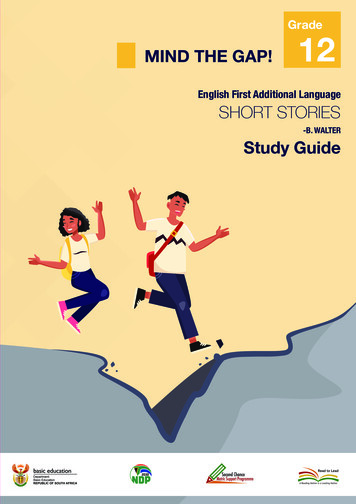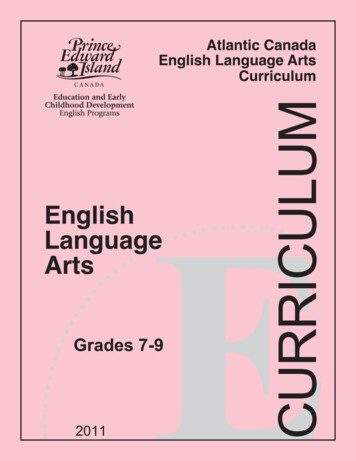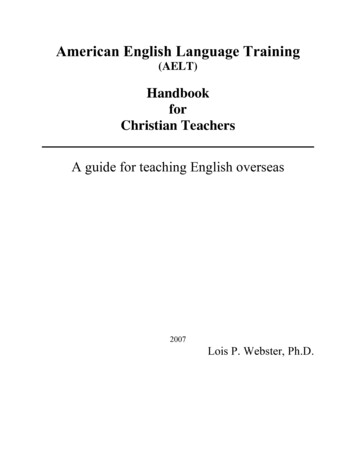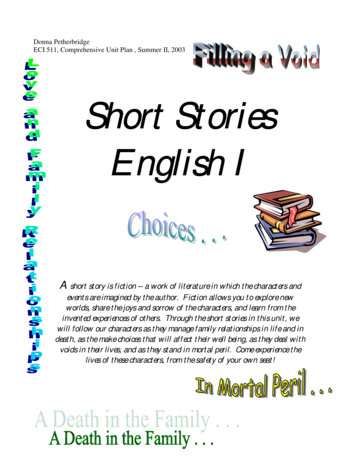
Transcription
GradeMIND THE GAP!12English First Additional LanguageSHORT STORIES-B. WALTERStudy Guide
MIND THE GAP!This content may not be sold or used for commercial purposes.Curriculum and Assessment Policy Statement (CAPS) Grade 12 English First Additional Language Mind the Gap studyguide for Short Stories: Changes: An anthology of short stories by B Walter.This publication has a Creative Commons Attribution Noncommercial Sharealike Licence. You can use, modify, upload,download, and share content, but you must acknowledge the Department of Basic Education, the authors and contributors.If you make any changes to the content you must send the changes to the Department of Basic Education. This contentmay not be sold or used for commercial purposes. For more information about the terms of the license please see: Copyright Department of Basic Education 2019222 Struben Street, Pretoria, South AfricaContact persons: Ms C. Weston and Dr S. MalapileEmail: Weston.C@dbe.gov.za / Malapile.s@dbe.gov.zaTel: (012) 357 4183 / 012) 357 3811http://www.education.gov.za Call Centre: 0800202933AcknowledgementsThe extracts from the short stories in this study guide are from Changes: An anthology of short stories by B WalterMind the Gap TeamSenior Project Leaders: Dr S. Malapile, Ms C WestonProduction co-ordinators:B. Monyaki, B. Ras, M. Phonela, M. NematangariAuthors: Mr Norman Fumba, Ms Renske Pieterse, Mr Harold Takalo, Mr Emmanuel Mpumelelo Thobela, Ms NonhlanhlaMzila, Ms Thembeka Mtolo, Ms Thokozile Joyfull Sabelo, Ms Monica Mamakara Karabo Seitei, Ms Elizabeth MarianneMeyer, Ms Doreen Mpho Mongale, Ms Vuyelwa Gladys Mnguni, Ms Pila Masakane and Mr Moses Nkosi.Critical reader: Monyaki BSDesigner and editor: Page82Onsite writers’ workshop support:J. Mphidi, V. Magelegeda, P. Hlabiwa, R. Maboye and N. MalopeDepartment of Basic Education 20202
MIND THE GAP!Ministerial ForewordThe Department of Basic Education remains steadfastly committedto innovative strategies aimed at enhancing learner attainment.Consistent with the government’s commitment in promoting theindigenous languages that form the tapestry of our democraticlandscape, this Mind the Gap Self study guide is a concretedemonstration of this commitment.The release of this self-study guide incorporates all the officialAfrican Home Languages focusing on the novel genre at this stage.Not only does the study guide incorporate the African languages, butit also incorporates South African Sign Language Home Language,Afrikaans Home Language and English First Additional Language.The Mind the Gap Literature Self Study Guide is responding to thebroader sectoral reading challenges that the country is experiencing.It seeks to strengthen the following strands of the National ReadingSector Plan: Teacher Development and Support; Direct LearnerSupport; and Provisioning and Utilisation of the Learning andTeaching Support Materials. Its interactive nature will make it easierfor both teachers and learners to read, to learn or study. It is hopedthat through this Study Guide, the reading and learning outcomeswill be achieved.Matsie Angelina Motshekga, MPMinister of Basic EducationKey terminologies are explained or illustrated in a simplified mannerand examples of the types of questions as a learner you may expectto be asked in an examination, are included in this study guide. Inorder to build your understanding, specific questions and possibleresponses forms part of the study guide package.The study guide is designed to appeal to any learner offering Grade12, whether as a part-time or a full-time candidate. Educators in thefield will also find it an invaluable resource in their practice.Every learner is a national asset, all you need now is to put in thehours required to prepare for the examinations and excel!We wish each and every one of you good luck and success.MRS AM MOTSHEKGA, MPMINISTERDATE: 14 NOVEMBER 20193Department of Basic Education 2020
MIND THE GAP!Table of contentsDear Grade 12 learner.6How to use this study guide.6Top 7 study tips.7On the exam day.7Overview of the English First Additional Language Paper 2: Literature exam.8Short Story 1: Transforming Moments by Gcina Mhlophe . .91.Summary .92.Title . .103.Themes . .104.How is the story told?. .114.1Setting.114.2Structure and plot development.114.3Characterisation .124.4Narrator’s point of view .124.5Style. .124.6Diction and figurative language.124.7Tone and mood.13Activity 1.14Short Story 2: The Last Breath by Sam Kahinga.161.Summary. .162.Title. .163.Themes. .164.How is the story told?.174.1Setting. .174.2Structure and plot development. .174.3Characterisation. .184.4Style. .184.5Narrator and point of view. .184.6Diction and figurative language. .184.7Tone and mood.18Activity 2. .19Short Story 3: Next Door by Kurt Vonnegut. .221.Summary. .222.Title. .233.Themes. .234.How is the story told?.234.1Setting.234.2Structure and plot development. .234.3Characterisation. .244.4Narrator and point of viewpoint . . . . 244.5Diction and figurative language . 254.5Tone and mood . .25Activity 3 .26Short Story 4: The New Tribe. .281.Summary . . .282.Title.283.Themes .284.How is the story told?.294.1Setting. .294.2Structure and plot development.294.3Characterisation .294.4Narrator and point of view. .304.5Diction and figurative language. .304.6Tone and mood. .30Activity 4. .31Short Story 5: A Chip of Glass Ruby by Nadine Gordimer. .331.Summary. .332.Title. .343.Themes. .34Department of Basic Education 20204
MIND THE GAP!4.How is the story told?. .354.1Setting. .354.2Structure and plot development. .354.3Characterisation. .364.4Style. .364.5Narrator and point of view. .364.6Diction and figurative language. .364.7Tone and mood. .37Activity 5.1. .38Activity 5.2. .39Short Story 6: Village People by Bessie Head. .421.Summary. .422.Title. .433.Themes. .434.How is the story told?. .434.1Setting. .434.2Structure and plot development. .434.3Characterisation. .434.4Style. .434.5Narrator and point of view. .434.6Diction and figurative language. .444.7Tone and mood. .45Activity 6. .47Short Story 7: The Fur Coat by Sean O’Foalain. .481.Summary. .482.Title. .483.Themes. .494.How is the story told?. .494.1Setting. .494.2Structure and plot development. .504.3Characterisation. .504.4Style. .504.5Narrator and point of view. .514.6Diction and figurative language. .514.7Tone and mood. .51Activity 7.1. .52Activity 7.2. .54Short Story 8: The Doll’s House by Katherine Mansfield. .561.Summary. .562.Title. .573.Themes. .574.How is the story told?. .584.1Setting. .584.2Structure and plot development. .584.3Characterisation. .584.4Style. .594.5Narrator and point of view. .594.6Diction and figurative language. .594.7Tone and mood.59Activity 8. .605Department of Basic Education 2020
MIND THE GAP!Dear Grade 12 learnerThis Mind the Gap study guide helps you to prepare for the end-of-yearGrade 12 English First Additional Language (EFAL) Literature exam.There are three exams for EFAL: Paper 1: Language in Context; Paper 2: Literature; and Paper 3: Writing.There are eight great EFAL Mind the Gap study guides which cover Papers 1, 2 and 3.Paper 2: Literature includes the study of novels, drama, short stories and poetry. A Mind the Gap study guide isavailable for each of the prescribed literature titles. Choose the study guide for the set works you studied in your EFALclass at school.This study guide focuses on the eight prescribed short stories examined in Paper 2: Literature. You will need to study alleight short stories for the exam:1.2.3.4.5.6.7.8.Transforming Moments by Gcina MhlopheThe Last Breath by Sam KahigaNext Door by Kurt VonnegutThe New Tribe by Buchi EmechetaA Chip of Glass Ruby by Nadine GordimerVillage People by Bessie HeadThe Fur Coat by Sean O’FaolainThe Doll’s House by Katherine MansfieldHow to use this study guideThere is one chapter for each of the short stories. Each chapter includes a summary, a brief statement of the importanceof the title, and the themes. More detail is given on how the story is told by examining: Setting;Structure and plot development;Characterisation;Style;Narrator and point of view;Diction and figurative language; andTone and mood.All of the above information is also summarised in a set of notes. Use these notes to hold the eight short stories clearlyin your mind.You can test your understanding of each short story by completing the activities and using the answers to mark yourown work. The activities are based on exam extracts.Learn all of the vocabulary lists for each short story at the end of each chapter.Look out for theseiconsIn the studyHints to help youremember a conceptorguide you in solvingproblemsPay specialattentionDepartment of Basic Education 20206Activoties withquestions foryou to annswer
MIND THE GAP!Try these Studytips to makelearning easier.Top 7 study tips1. Break your learning up into manageable sections. This will help yourbrain to focus. Take short breaks between studying one section andgoing onto the next.2. Have all your materials ready before you begin studying a section –pencils, pens, highlighters, paper, glass of water, etc.3. Be positive. It helps your brain hold on to the information.4. Your brain learns well with colours and pictures. Try to use themwhenever you can.5. Repetition is the key to remembering information you have to learn.Keep going over the work until you can recall it with ease.6. Teach what you are learning to anyone who will listen. It isdefinitely worth reading your revision notes aloud.7. Sleeping for at least eight hours every night, eating healthy foodand drinking plenty of water are all important things you need to dofor your brain. Studying for exams is like exercise, so you must beprepared physically as well as mentally.Use this studyguide as aworKbook Makenotes, draw pictires,and highlightimportant ideas.On the exam dayi.Make sure you bring pens that work, sharp pencils, a rubber and a sharpener. Make sure you bring your IDdocument and examination admission letter. Arrive at the exam venue at least an hour before the start of theexam.ii.Go to the toilet before entering the exam room. You don’t want to waste valuable time going to the toiletduring the exam.iii. You must know at the start of the exam which two out of the four sections of the Paper 2 Literature exam you willbe answering. Use the 10 minutes’ reading time to read the instructions carefully.iv. Break each question down to make sure you understand what is being asked. If you don’t answer the questionproperly you won’t get any marks for it. Look for the key words in the question to know how to answer it. You willfind a list of question words on page xii of this study guide.v.Manage your time carefully. Start with the question you think is the easiest. Check how many marks are allocatedto each question so you give the right amount of information in your answer.vi. Remain calm, even if the question seems difficult at first. It will be linked with something you have covered. If youfeel stuck, move on and come back if time allows. Do try and answer as many questions as possible.vii. Take care to write neatly so the examiners can read your answers easily.7Department of Basic Education 2020
MIND THE GAP!Overview of the English FirstAdditional Language Paper 2:Literature ExamIn the Paper 2 Literature exam, you need to answer questions from two sections. Choose the two sections that youknow best: Section A: NovelSection B: DramaSection C: Short storiesSection D: PoetryA total of 70 marks is allocated for Paper 2, which means 35 marks for each section you choose.You will have two hours for this exam.Here is a summary of the Paper 2 Literature exam paper:QuestionnumberTitleType of questionNumberof marksSection A: Novel - If you choose Section A, answer ONE question.Choose the question for the book you have learnt.1Cry, the Beloved CountryContextual352The Strange Case of Dr Jekyll and Mr HydeContextual35Section B: Drama - If you choose Section B, answer ONE question.Choose the question for the play you have learnt.3MacbethContextual354My Children! My AfricaContextual35Section C: Short stories - If you choose Section C, answer BOTH questions. You will not know exactly whichshort stories are included until the exam. TWO stories will be set. Answer the questions set on BOTH short stories.5.1Short storyContextual17 or 185.2Short storyContextual17 or 18Section D: Poetry - If you choose Section D, answer BOTH questions. You will not know exactly which poems areincluded until the exam.TWO poems will be set. Answer the questions set on BOTH poems.6.1Poem 1Contextual17 or 186.2Poem 2Contextual17 or 18NB* You don’t have to answer all the sections in Paper 2.* Before the Exam starts you must know which two sections you are to answer.* When the Exam starts, find your two chosen sections.* Make sure to number answers correctlty-according to the numbering systemused in the exam paper- for the two sections you’ve chosen.* Start each section on a new page.Department of Basic Education 20208
MIND THE GAP!Transforming Moments1by Gcina MhlopheNokugcina Elsie Mhlophe (born 1958) is a well-known South African anti-apartheidactivist, actress, storyteller, poet, playwright, director and author. Storytelling is a deeplytraditional activity in Africa and Mhlophe is one of the few women storytellers in a countrydominated by males. Mhlophe was born in 1958 in KwaZulu-Natal to a Xhosa motherand a Zulu father. She started her working life as a domestic servant, later working as anewsreader at the Press Trust and BBC Rad
Paper 2: Literature includes the study of novels, drama, short stories and poetry. A Mind the Gap study guide is available for each of the prescribed literature titles. Choose the study guide for the set works you studied in your EFAL class at school. This study guide focuses on the eight prescribed











